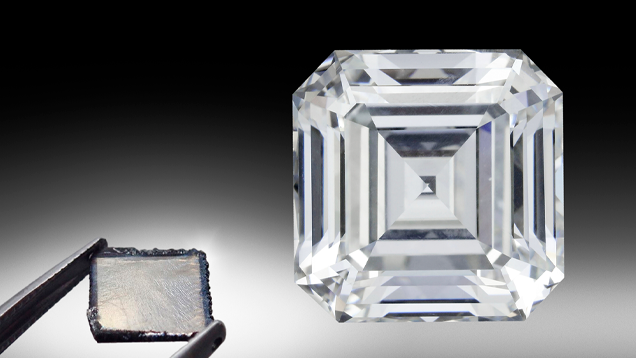
G&G in a Flash: The Latest on Lab-Grown Diamonds
Share
Industry analysts predict that by 2025, 20% of all diamonds on the market will be lab-grown. In fact, the gemstone industry has seen a significant increase in the quantity, size, and quality of lab-grown diamonds in recent years. And GIA currently averages more CVD-grown diamond shipments per day than it ever did in an entire year. Therefore, it is more important than ever to understand the production, processing, and identification of lab-grown diamonds. This article discusses the key trends that GIA has observed since 2007, when it began issuing lab-grown diamond grading reports.
Laboratory growth and treatment methods
Most lab-grown diamonds that pass through GIA's labs are grown by CVD (chemical vapor deposition), with most undergoing post-growth HPHT (high pressure, high temperature) treatment to remove their color.
CVD Diamonds
When the first CVD diamonds were produced in 1952, the quality and sizes of the crystals were not suitable for jewelry. Some gem-quality diamonds began to appear in the 2000s. In recent years, however, rapid advances in technology have resulted in large quantities of high-quality gem diamonds grown using CVD.
CVD diamond growth relies on a chemical process very different from natural diamond formation. This technique involves a reactor in which hydrogen and hydrocarbon gases (typically methane) are flowed over one or more diamond substrates. Microwaves are used to activate a plasma, triggering a series of reactions required to deposit diamond material on the seeds. Hydrogen, which accounts for 90–99% of the gas mixture, suppresses the growth of graphite or non-diamond-bearing carbon, which would hinder the formation of high-quality diamonds. 
Although the CVD method was developed earlier, the first gem-quality lab-grown diamonds were produced using the HPHT method. The HPHT method mimics some of the conditions under which natural diamonds form. A solid carbon source, typically graphite powder, is subjected to pressures of 5–6 GPa (equivalent to a depth of 150–190 km inside the Earth) and temperatures of 1300–1600 °C, higher than those for natural diamond formation (~1040–1250 °C), allowing rapid growth. HPHT growth occurs within a capsule that includes a carbon source, a metal flux to dissolve the carbon to aid growth, and a diamond seed to initiate the process. The temperature of the diamond seed is lower, so that the carbon supersaturates and crystallizes out of the metal solution. An HPHT diamond typically takes anywhere from an hour to a few weeks to grow, depending on the desired size and quality.
For both methods, a diamond substrate (often called a “seed” in HPHT growth) is used to create the crystal blueprint from which the new diamond is created. The quality, size, and preparation of the substrate can have a significant impact on the resulting diamond.

Color, Clarity and Carat Weight
Color
Prior to 2020, most CVD-grown diamonds were “near-colorless,” with color grades ranging from G to N. In the mid-2010s, many CVD-grown diamonds were also gray in color. 2020 saw a significant increase in shipments of colorless-grade diamonds (D, E, or F), likely due to improvements in growth and treatment procedures. Manufacturers are constantly—and successfully—refining their growth and treatment procedures to produce large, colorless diamonds.
Most of the early HPHT-grown diamond shipments observed at GIA starting in 2007 were either orange-yellow due to nitrogen impurities or blue due to boron. Over the past 10 to 15 years, manufacturers have successfully eliminated nitrogen, the primary cause of orange-yellow color, from lab-grown diamonds. Since then, there has been a sharp decline in shipments of orange-yellow HPHT-grown diamonds, with colorless specimens now accounting for the vast majority of shipments. In the years 2021 to 2023, more than 90% of HPHT-grown diamond intake was colorless—a trend that likely reflects consumer preferences.
Some CVD-grown diamonds have a brown coloration after growth. Like natural brown diamonds, CVD-grown diamonds can be enhanced using HPHT treatments to reduce or remove the brown coloration. Although similar equipment can be used for HPHT treatment and HPHT growth, the underlying methods are different. HPHT treatments are conducted at higher temperatures than those used for HPHT growth (>1600 °C) and do not result in additional diamond material. Low-pressure, high-temperature (LPHT) treatment, in which samples are annealed at similarly high temperatures under vacuum or inert gas, can also be used to alter the color of CVD-grown diamonds.
CVD manufacturers can therefore use recipes that promote rapid growth of diamond layers, even if this results in brown coloration, and then improve the color grade through post-growth annealing. This approach can be faster, easier, or more cost-effective than directly producing a colorless diamond using CVD. Over time, the percentage of CVD-grown diamonds showing signs of annealing treatment has steadily increased. As of 2020, approximately 80% of CVD-grown diamonds submitted to GIA have undergone post-growth processing.

Clarity
Growing large, colorless, high-purity HPHT-grown diamonds is particularly challenging, as it requires complex ingredient and recipe development to minimize nitrogen content, as well as the ability to carefully control conditions over long periods of time. Nitrogen accelerates diamond growth, so its absence reduces growth rates. While CVD-grown diamonds can be created in a series of growth steps, HPHT-grown diamonds are produced in a single, uninterrupted run, making a highly controlled environment all the more necessary.
Carat weight
The size of gem-quality CVD-grown diamonds has increased dramatically over time. From 2000 to 2010, most CVD-grown diamonds submitted to the GIA were less than half a carat. Today, most of them exceed 3 ct. This change in size reflects improvements in CVD methods as well as the availability of larger diamond substrates. The years since 2010 have seen a very rapid increase in size. In January 2022, the largest faceted CVD-grown diamond was 16.41 ct. Since then, the benchmark has more than quadrupled to 75.33 ct.
Some HPHT-grown diamonds exceed 100 carats in size. The largest recorded lab-grown diamond is a 150.42 ct good-quality HPHT-grown crystal created in November 2021.

Global producers of lab-grown diamonds
An industry report estimated that 6–7 million carats of gem-quality lab-grown diamonds were produced globally in 2020. China produced approximately 3 million carats (mostly HPHT), followed by India with about 1.5 million carats (mostly CVD) and the United States with about 1 million carats (mostly CVD).
Market leaders in China use the HPHT method to mass produce small to medium-sized products and diamond grains and powders for abrasives. Chinese CVD producers also grow high-quality gemstones, including large untreated colorless diamonds and pink and blue diamonds.
India has an estimated 4,000–6,000 CVD reactors based in Surat, Gujarat state, which is also the world's leading diamond cutting and polishing center. A company there produced the largest known faceted CVD diamond to date, a 75.33 ct square emerald cut displayed at the 2024 JCK Las Vegas show. The original crystal took nine months to grow. In 2023, Indian Prime Minister Narendra Modi presented First Lady Jill Biden during a visit to the White House with a 7.50 ct CVD-grown diamond of F color and VVS 2 clarity , demonstrating the increasing prestige and importance of lab-grown diamonds.
CVD diamond production in the United States originated in the semiconductor industry. Diamond's remarkable properties—including high hardness, high thermal conductivity, low thermal expansion, wide optical window, biocompatibility, and high resistance to corrosion, acid, and radiation—have a wide range of engineering applications.

Did you know that the vast majority of colorless to near-colorless lab-grown diamonds are Type II, meaning they have no detectable nitrogen impurities? In contrast, only about 1% of natural diamonds are Type II. Therefore, most diamonds that undergo extensive analysis to determine whether they are lab-grown are Type II.
